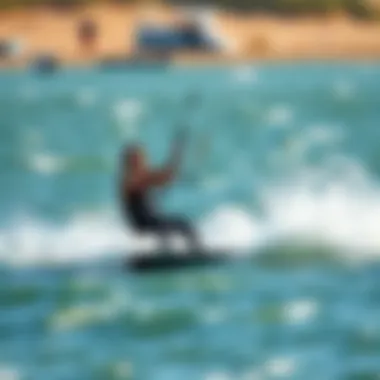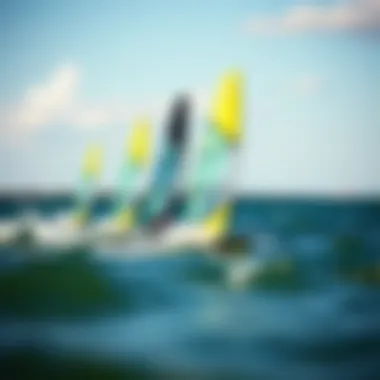Foil vs Starboard: Key Differences in Kiteboarding


Intro
Kiteboarding has burgeoned from a niche activity into a thrilling sport enjoyed by enthusiasts across the globe. The choice between foil boards and starboard boards is more than just a matter of personal preference; it is a decision that can significantly influence your riding experience. Understanding these distinctions can enhance not only your performance but also your overall enjoyment on the water. What's so special about these boards? Well, let’s dive into their unique characteristics and how they can cater to different styles and skill levels.
Foil boards are characterized by their hydrofoils, which allow riders to lift above the water’s surface. This design improves speed and efficiency, especially in light wind conditions. On the other hand, starboard boards offer a more traditional kiteboarding experience that may favor stability and versatility across various water states.
Two types of riders may significantly benefit from knowing the differences. Newcomers might seek a more forgiving experience to build skills, while seasoned kiteboarders may desire maneuvers that enhance their current performance. Therefore, understanding the specific advantages of each board type is crucial for maximizing your time spent on the water.
Prologue to Kiteboarding Boards
The world of kiteboarding offers a thrilling experience, and choosing the right equipment is vital for both performance and safety. In this section, we aim to shed light on the significance of kiteboarding boards, specifically focusing on the differences between foil and starboard boards. A thorough understanding of these boards equips enthusiasts with the knowledge needed to enhance their kiteboarding journey.
Understanding the Basics
Kiteboarding has soared in popularity, attracting individuals eager to ride the wind and waves. At the center of this exhilarating sport lies the kiteboarding board, which plays a crucial role in how riders interact with their environment.
Foil boards, for instance, feature a hydrofoil that lifts the board above the water as speed increases, allowing for smoother rides and tackling choppy waters with grace. However, their unique structure requires riders to adapt their technique, navigating with a different balance than traditional boards. On the flip side, starboard boards, which are flat and typically wider, provide enhanced stability and versatility, making them a good choice for beginners or those enjoying leisurely rides.
Understanding these foundational aspects sets the stage for more detailed comparisons, ensuring that kiteboarding enthusiasts can make informed decisions that align with their riding styles.
Importance of Board Selection
Selecting the right kiteboarding board is not a mere technicality—it's an essential factor that influences enjoyment, performance, and safety on the water. With an array of options, each with its unique characteristics, riders must consider various factors.
- Skill Level: Boards designed for advanced riders often require refined skills and techniques, while beginner boards focus on maximizing ease of use.
- Conditions: Different boards perform optimally in varying conditions, such as flat water versus waves, and selecting the correct type can result in significantly better performance.
- Riding Style: Whether one craves speed, jumps, or simply gliding across the water, understanding the intended use of each board can help in making a fitting choice.
Choosing a board that complements one's skill level and style can improve overall performance and enjoyment.
"The choice of rigging—not just the kite, but the board—significantly impacts the riding experience. As with anything in life, the right tools can make all the difference."
In summary, kiteboarding boards are more than a piece of equipment; they are the interface between the rider and the elements. The right selection leads to enhanced performance and long-lasting enjoyment, forming the basis for mastering the art of kiteboarding.
Overview of Foil Boards
Foil boards represent a distinct and innovative section of the kiteboarding world, setting themselves apart with a unique design and functional capabilities. As kiteboarding continues to evolve, the spotlight on foil boards has grown brighter, attracting both veterans and newcomers alike. Understanding the intricacies of foil boards is crucial for anyone looking to tailor their riding experience, so let’s dive deeper into this fascinating topic.
What is a Foil Board?


A foil board is essentially a specialized board that is equipped with an elongated fin, known as a foil, which extends beneath the water. This foil consists of a mast attached to a wing-like structure that provides lift as the rider gains speed. Unlike traditional kiteboarding boards that remain in contact with the water at all times, foil boards enable the rider to rise above the surface, gliding on the water with minimal resistance. This unique capability opens up a world of possibilities in terms of performance and navigation.
Key Features of Foil Boards
When one looks at foil boards, several defining features stand out:
- Construction: Most foil boards are crafted from lightweight materials such as carbon fiber or high-density foam. This design choice ensures that the board can achieve lift more easily without burdening the rider.
- Mast and Wing Design: The length and shape of the mast, as well as the surface area of the wing, critically influence performance. A longer mast can provide greater lift but may affect stability, whereas a larger wing can offer smoother rides in lighter winds.
- Footstraps or Bindings: Depending on personal preference, riders can choose boards with footstraps for easier maneuvering or bindings for a more secure fit.
- Size Variability: Foil boards come in numerous sizes to accommodate different rider weights and skill levels, which helps optimize the ride experience.
Benefits of Using Foil Boards
The advantages of utilizing a foil board are manifold:
- Lift and Speed: The ability to lift above water means significantly less drag. This characteristic allows for greater speeds even in light wind conditions, thus extending the kiteboarding season.
- Less Impact from Choppy Waters: Riders often find that the transition onto a foil board allows for smoother navigation through rough water, reducing jarring shocks that can come from hitting waves.
- Exploration of New Spots: The performance of foil boards makes them suitable for a wider range of conditions and locations, providing the opportunity to ride in areas that may not have been thought accessible for traditional kiteboards.
- Greater Control: Once accustomed to the nuances of riding a foil board, many riders appreciate the enhanced maneuverability and feeling of control.
Ideal Conditions for Foil Boarding
While foil boards are versatile, there are specific conditions where they truly shine:
- Light to Moderate Winds: Foiling excels in lighter winds since the lift generated by the foil allows riders to progress without much force from the kite.
- Flat or Slightly Choppy Water: Foil boarding can be somewhat challenging in heavy chop. Smooth waters allow better performance and easier control.
- Open Spaces: Riding in expansive locations can be beneficial, as foil boards require ample room for turns and maneuvers without obstructions.
In sum, foil boards represent an exciting advancement in kiteboarding. Their unique design and operational advantages not only enhance the riding experience but also expand the horizons for what is possible on the water. For those eager to explore kiteboarding at a new level, understanding and mastering foil boards can be a rewarding journey.
Overview of Starboard Boards
In the world of kiteboarding, understanding the nuances between different types of boards can make or break the riding experience. The Starboard board, in particular, holds a significant position for many enthusiasts. This type of board's unique characteristics and features set it apart, making it essential for individuals wanting to enhance their kiteboarding skills.
Starboard boards are crafted with precision to deliver a blend of performance and versatility, catering to both novices learning the ropes and seasoned riders seeking the thrill of advanced maneuvers. They are recognized for their stability and responsiveness in diverse water conditions, positioning themselves as a favored choice among kiteboarders.
What is a Starboard Board?
Starboard boards refer to a specific design in the niche of kiteboarding that has gained popularity for its engineered stability and adaptability. Initially developed for traditional surfing, the concept has evolved into highly specialized boards tailored for the demands of kiteboarding. These boards generally sport a wider shape, designed to give riders better balance while executing technical tricks.
Typically, a Starboard board consists of lightweight materials, optimizing ease of handling and maneuverability. Riders often choose this board type when they prioritize control during their sessions on the water.
Key Features of Starboard Boards
Several distinct features characterize Starboard boards, contributing to their appeal among kiteboarders:
- Wider Outline: The broader shape supports stability, providing a solid foundation for beginners and an advantageous base for performing tricks.
- Durability: These boards are built to withstand the rigors of the sport, often using robust materials that resist wear and tear.
- Lightweight Design: The construction emphasizes a light feel, which is crucial for aerial maneuvers and quick turns.
- Versatile Rocker Line: This aspect helps in maintaining speed and maneuverability, enabling a fluid ride over varying water conditions.


Each of these features plays a key role in enhancing the overall user experience, making Starboard boards a reliable choice for a broad range of kiteboarding activities.
Advantages of Starboard Boards
Choosing a Starboard board provides numerous advantages for kiteboarders. Some of the top benefits include:
- Enhanced Control: The design allows riders to perform with better precision, especially in challenging environments.
- Smooth Ride: The construction minimizes drag. Therefore, riders can glide effortlessly through water, even when faced with chop or small waves.
- Easier Progression: For beginners, Starboard boards simplify the learning curve, empowering riders to gain confidence in their skills more rapidly.
- Compatibility: Many Starboard boards are designed to work with a variety of kite setups, allowing riders the flexibility to experiment with different gear.
Ideal Conditions for Starboarding
The riding conditions for Starboard boards can greatly influence performance. While versatile, they perform best under specific circumstances:
- Moderate Wind Speeds: Typically, wind ranging from 10 to 20 knots is ideal. This range provides enough lift while maintaining stability.
- Flat to Slightly Choppy Water: Starboard boards shine in relatively calm waters, though their structure also handles light chop decently.
- Warm Temperatures: Riding in warmer climates can enhance performance, as the materials used often react favorably to temperature, ensuring comfort for riders.
Comparative Analysis of Foil and Starboard Boards
When delving into the world of kiteboarding, understanding the distinctions between foil and starboard boards is essential. Each type of board caters to different riding styles, skill levels, and environmental conditions. The comparative analysis not only informs one’s choice of equipment but also enhances overall kiteboarding experience. A clearer grasp of each board's performance characteristics can lead to more tailored riding sessions, allowing kiteboarders to optimize their time on the water.
Performance Metrics
Performance metrics play a pivotal role in gauging how well each board interacts with the water and responds to the rider's commands. For instance, foil boards typically have a unique design that allows them to glide above water, dramatically reducing drag. This leads to faster speeds and smoother rides, especially on choppy waters. In contrast, starboard boards provide solid stability and are built for more direct engagement with the waves.
- Speed: Foil boards are generally faster due to their aerodynamic design; they can reach planing speeds quickly.
- Acceleration: Foiling involves less resistance, which means quicker acceleration in certain wind conditions compared to starboarding.
- Ride quality: The sensation of riding a foil can feel quite surreal, as it elevates the rider above the waves, while starboard boards offer a more traditional ride experience that's often more familiar to beginners.
Stability and Maneuverability
When we talk about stability and maneuverability, the differences between foil and starboard boards are underscored. Foil boards, while they excel in speed, can feel unstable initially, especially for newcomers. The experience can be akin to learning to ride a bicycle without training wheels. With some practice, riders gain confidence and allow for incredible maneuverability in the air and quick directional changes.
In contrast, starboard boards are well-known for their user-friendly stability. They provide a grounded feel, making them a go-to option for many novices.
- Stability: Starboard boards are often favored for their inherent stability, making them suitable on windy days or choppy conditions.
- Maneuverability: Foil boards allow for sharp turns and flips more effectively, rewarding skilled riders with exciting tricks and aerial moves.
Adaptability to Conditions
Adaptability is crucial in ensuring an enjoyable kiteboarding session. Foil boards truly shine in lighter wind conditions. Their ability to rise above water enables them to perform in winds that would leave traditional boards stranded.
On the flip side, starboard boards thrive in a broader range of conditions, making them more versatile overall. Whether one is battling through waves or cruising on flat water, starboards adjust better to varied environments.
- Wind conditions: Foil boards are best for light winds; they can plane on mere whispers of breeze.
- Wave interaction: Starboard boards lend themselves nicely to wave riding, offering a more predictable experience when dealing with challenging surf.


In summary, evaluating perspectives such as performance metrics, stability and maneuverability, and adaptability to conditions provides kiteboarders with a comprehensive understanding of these contrasting boards. Whether distinguishing between foil and starboard boards for a casual ride or an adrenaline-fueled adventure, such insights enable informed decision-making for kiteboarding enthusiasts.
"Understanding these differences is akin to the difference between a dolphin and a boat; each excels in distinct water but for entirely different reasons."
For those looking to dive deeper into the technicalities of kiteboarding, resources such as Wikipedia, Britannica, and community discussions on Reddit provide ample insights and shared experiences.
Practical Considerations When Choosing a Board
Choosing the right board for kiteboarding can be the difference between a pleasant day on water and a frustrating experience. Understanding practical considerations when selecting a board is crucial for both novice and expert riders. This section breaks down the essential factors to keep in mind when making your selection. Not every board suits every rider, so being aware of your needs is half the battle.
Skill Level and User Experience
Your skill level plays a significant role in the board you choose. If you’re just starting, you might find a board that offers stability and ease of control more suited to your needs. These boards often have a larger surface area, making them more forgiving as you learn to balance and maneuver. For instance, a wider starboard board might help beginners maintain stability as they hone their skills.
On the flip side, if you’re a seasoned kiteboarder, you’ll likely be on the hunt for something that enhances your performance. Foil boards, for example, require a certain level of expertise due to their unique riding dynamics. They allow for advanced tricks and higher speeds, but if you’re not equipped for it, you could quickly feel out of your depth.
In short, think about how long you’ve been kiteboarding and how comfortable you feel riding in various conditions. Consider this: a board that complements your current abilities can foster confidence and minimize the steep learning curve.
Budgetary Considerations
When managing your finances for a kiteboarding board, it’s easy to get lost in a sea of options. Prices range widely, and while it’s tempting to go for the flashiest model, quality often trumps aesthetics.
Here are some pointers to keep in mind:
- Initial Investment: Don’t just look at the price tag. Assess the board's durability and how well it fits your intended usage. A higher-quality board might cost more upfront but can save you from frequent replacements.
- Long-Term Costs: Don’t forget to factor in the cost of accessories like straps, fins, or even gear maintenance. A cheaper board might end up being more expensive in the long run if it requires frequent repairs or additional purchases.
- Resale Value: Some brands hold better resale value than others. If you have an eye on upgrading later, consider how much you might recoup. Brands like Naish or Slingshot often have a reputation that sustains value over time.
This way, aligning your budget with long-term plans and real possibilities can help prevent future headache.
When choosing a kiteboarding board, always remember that quality and comfort can elevate your experience exponentially. It’s not just about how much you can afford; it’s about what you truly need.
By reflecting on these considerations, you can make a more informed decision that aligns with your skill level and budget, ultimately enhancing your kiteboarding adventure.
The End
As we wrap up our exploration on foil boards and starboard boards, understanding the concluding points is crucial for both seasoned riders and newcomers alike.
Key Takeaways
- Board Purpose: Each board type serves unique purposes. Foil boards are excellent for those looking to glide over the water with minimal drag, while starboard boards typically offer more traditional riding experiences with better stability.
- Performance Factors: Differences in how each board performs under various conditions can dramatically affect your riding experience. Foil boards excel in light winds and choppy waters, while starboard boards may be better suited for strong winds and larger waves.
- Skill Adaptation: As you deepen your kiteboarding skills, being aware of how each board aligns with your growth is essential. Foil boards often present a steeper learning curve but can offer greater rewards once mastered.
- Environmental Considerations: Wind patterns, water conditions, and personal preferences should influence your board choice. Matching your equipment to the environment can make a world of difference in performance and enjoyment.
Final Recommendations
If you're just dipping your toes into the world of kiteboarding, choosing the right board type can set the stage for your entire experience. Here are a few recommendations:
- For New Riders: Starboard boards are generally more forgiving and may provide a better initial experience for beginners learning the ropes. The stability they offer helps in building confidence quickly.
- For Intermediate to Advanced Users: Once you're comfortable, consider trying a foil board. They elevate the riding experience significantly, allowing for exciting maneuvers and enhanced speed.
- Evaluate Your Environment: Before making a decision, take a good look at where you tend to ride. If the conditions favor lighter winds, a foil board could enhance your sessions. Conversely, if you typically face robust winds, a starboard board might be your best bet.
- Invest in Quality: Regardless of the board type you choose, it's always wise to invest in quality equipment. A well-made board not only improves your performance but ensures safety on the water.















